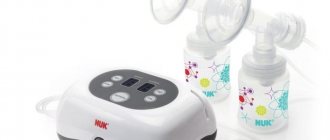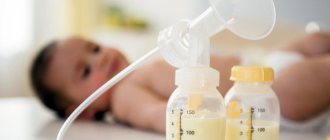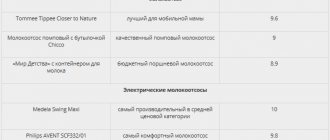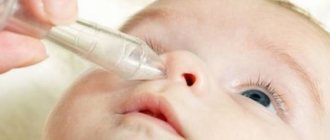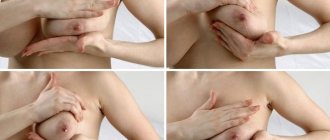With the birth of a child and the beginning of breastfeeding, a young mother faces the question of how to express milk from the breast.
Expressing can be done by hand, but if for some reason a woman cannot do this (for example, cracks have formed on the nipple or lactostasis has appeared and the breast is very painful), a breast pump comes to the rescue. There is a huge selection of both manual and electronic devices on the market. But one of the most popular brands among mothers is Philips appliances. To avoid problems with assembly, we suggest looking at how to do it correctly using the example of a Philips Avent manual breast pump (the video shows the assembly of a manual and electric device).
Briefly about breast pumps
A manual breast pump is a simple, inexpensive and silent device that allows a woman to express milk without discomfort or pain. Using the device, you can independently control the force of pumping, changing the intensity, and increase/decrease the force of hand pressure.
The device itself is easy to use, easy to assemble, transport, store, all parts are sterilized. In this case, you can use the breast pump as needed, and then wash it and put it away until next time.
The device may include bottles of different sizes and nipples for feeding the baby, as well as containers for subsequent freezing of milk.
Characteristics of the Avent breast pump
The Avent breast pump is equipped with a special massage nozzle for pumping, a milk bottle (125 ml) with a lid, a soft silicone teat of physiological shape, and a lid for transporting the device. The product body, depending on the model, is equipped with a handle or an electronic control unit with a power regulator. Also included are 4 bra pads.
You can purchase additional accessories for the breast pump - bags and containers for storing milk. The parts of the device do not contain a dangerous carcinogen - bisphenol A. Therefore, the milk passing through it does not contain harmful impurities and can be safely used to feed the baby.
Why pump at all?
The need to express milk may arise in a number of cases:
- Biological features of the mammary glands. Otherwise, the problem is referred to as tight breasts. A breast pump will help to “unpump” your breasts and maintain breastfeeding.
- Mom and baby are temporarily separated, for example, the mother is in the hospital or has left. In this case, relatives or a nanny can feed the baby using the prepared milk.
- A lot of milk is produced in the breast, some of which the baby does not eat, and stagnation occurs.
- The mother is forced to go to work, but wants to breastfeed her baby.
- The baby refused to breastfeed, preferring the easy option - mommy's milk from a bottle.
- Insufficient amount of breast discharge in a woman. Additional pumping and thereby stimulating the mammary glands using a breast pump will lead to the appearance of more milk.
- Painful sensations when feeding a baby, caused by the presence of cracks or wounds on the nipples or improper latching of the nipple.
- The mother is taking medications that pass into milk. In this case, having a supply of breast milk at home, you can feed the baby from the nipple, giving the baby the best and natural nutrition.
Therefore, in these cases, a breast pump will come to the rescue as an alternative to manual expression.
Types of manual breast pumps, their pros and cons
Manual breast pumps are divided into several groups:
- Piston.
- Syringe.
- With pear.
- Pump or vacuum.
Each device has pros and cons of use. The positive aspects of a manual breast pump are:
- quiet operation;
- no need to constantly recharge the device, batteries or accumulators;
- the ability to regulate the force of pumping;
- painless pumping;
- The breast pump and its parts can be easily washed with soap or soda solution and sterilized.
Some mothers also noted the negative aspects of the device:
- The device works efficiently, but slowly. You have to pump your breasts for a long time.
- Feeling tired in the hands after intensive use.
- Not durable parts, lack of spare parts.
However, when choosing a suitable breast pump model, you need to be guided by your own feelings and comfort when expressing.
Piston
The easy-to-use device is equipped with a special piston, thanks to which milk is released. The device operates silently. The disadvantage is that after intensive and long pumping, the mother becomes tired or feels pain in her hands.
Syringe
The device consists of two cylinders located one inside the other. The first cylinder is applied to the breast and nipple. And the second cylinder makes rhythmic movements. Thanks to this, a vacuum is formed inside the device, which promotes the release of milk or colostrum from the breast.
Pump-action
The device consists of a pump, nozzle and bottle. Due to the formation of a vacuum, expression occurs. The disadvantage of the device is the inability to sterilize all parts.
Pear
The device includes a rubber bulb and a nozzle. A breast pump with a bulb operates on the principle of a pump device. Suitable for mothers who rarely have to express, as it requires special skill when working. Can be sterilized.
What is a breast pump
This device consists of 3 parts. One part is in the form of a funnel for applying to the chest, the other part is a container for collecting liquid, and between them the third part is the suction mechanism itself from the first part and transferring the extracted material to the second. This intermediary part can be mechanical (driven by arms or legs) and electrical (powered by mains or batteries).
Activated by rhythmic hand pressing on a pear or lever
The principle of operation of breast pumps is that a vacuum is created inside the system and the nipple is drawn into the funnel, which causes pressure on the mammary glands, which perceive this process as natural sucking by the baby. The breast begins to release the accumulated milk and produce a new portion - all this flows into the bottle/cup/bag.
Single-phase operate in single-tone mode; biphasic first stimulate the breasts and then begin suction; clinical ones have even finer settings and additional accessories. Some models are designed for both breasts at once
The entire structure of the breast pump is currently made of polypropylene, and it is preferable that it is medical grade (this should be taken into account when choosing, paying attention to the corresponding packaging icons). A silicone pad is usually placed on the funnel-shaped part, which makes the pumping process painless and also stimulates the nipple area, giving the woman the feeling of naturally feeding the baby. This is not only convenient, but also important for the psychological side of the issue, since the brain needs to be deceived so that it sends the correct signals to the organ.
Video: how to choose a device
Which type should I choose?
It is impossible to say for sure which breast pump is the best. Each model has different characteristics and functionality. The undisputed leader in popularity is the Avent device, which is distinguished by wear-resistant parts and ease of use. At the same time, the Avent piston manual breast pump is not inferior to electric devices, but the price of the device is quite high.
In addition to Avent, you can look at budget models with less functionality, which are also considered the best on the market:
- Pigeon two-phase 16733. High-quality Japanese breast pump, characterized by a two-phase operation system.
- A two-phase manual breast pump that stimulates the amount of breast discharge and expresses slowly, gently.
- Canpol Babies Basic is a device from a well-known company producing children's products. It has good quality and a decent reputation among mothers.
- Domestic products, “World of Childhood” - pump-action devices with a bulb at an affordable price.
Mechanical or electrical?
When choosing a breast pump, many mothers prefer mechanical models. Firstly, such a device does not require connection to an outlet, which is important in the realities of Russian maternity hospitals, where beds are not always equipped accordingly. Secondly, you can take a manual breast pump with you on a trip or for a walk. In addition, for unprepared breasts, a device with a manual mechanism will be much more effective than an electric one.
An electric breast pump is suitable for nursing mothers with active milk production. These models have several operating speeds that can be adjusted without interrupting the pumping process. Since this is a rather lengthy and labor-intensive procedure, with such a breast pump the mother gets less tired. All you need to do is hold the device at the right angle and control the milk output.
For the first days in the maternity hospital, a manual breast pump is suitable. Whether other options will be needed will become clear later, when lactation is established and milk volume begins to increase.
How to assemble the device
How to assemble a manual breast pump is discussed using the Philips Avent device as an example.
Before assembling the device, you need to:
- Check all parts, wash, sterilize.
- Wash the hands.
Attention! It is more convenient to assemble the device when the parts of the device are still wet.
Assembly of the device:
- Insert the white valve into the device body from below so that the side with the star image is on top. Press the valve all the way.
- Place the breast pump body on the bottle included in the kit and turn clockwise until it stops.
- Insert the silicone diaphragm with the rod tightly into the device body. It is important that the part fits tightly and hermetically along the edge of the case, otherwise the device will not work.
- Place the forked end of the handle on the diaphragm rod. Press the handle until it clicks.
- Place the massage pillow into the funnel of the device. Check the tightness and tightness of the fastening.
- Close the top of the device with the lid, inserting it until it clicks.
After use, disassemble the device into parts, wash and sterilize.
Benefits of the Phillips Avent brand
Any breast pump has its own modification. The cheapest domestic or Chinese-made options have primitive mechanics and are not particularly easy to use. And the Avent breast pump, manual or automatic, can be called an excellent option in terms of price and quality. Among its advantages:
- ease of use - each Avent model is equipped with soft attachments. They fit nipples regardless of their shape. The application completely imitates the process of feeding a baby naturally, and you can also regulate the force of expressing milk. The process is comfortable and allows you to care for your breasts;
- easily replaceable parts - all structural elements can be replaced if lost or damaged;
- safety - all parts of the device do not contain substances that decompose over time and negatively affect the health of the child and mother;
- ease of care and operation - any model is easy to start if it is automatic, you just need to press the right button. And the Avent manual breast pump is also very simple. Devices of any modification are easy to disassemble and wash.
The device is very easy to use. It is recommended to study the characteristics during pregnancy. Then in the maternity hospital, when it is needed, there will be no problems.
How to properly express breast milk with a manual breast pump?
To learn how to pump correctly and quickly, you need to follow simple rules:
- Before using parts of the breast pump, boil and dry. Assemble the device itself. Disinfect your hands by washing them with soap. It's comfortable to sit down.
To increase lactation, drink a cup of warm tea or milk or take a warm shower.
- Place the nipple in the middle of the massage nozzle of the device. Fix the chest position with your right hand. There should be no pain or discomfort.
- Gently begin to press the lever or pear, gradually increasing the intensity of the presses. First, the first milk droplets will appear, and then the milk will flow in several streams. How long you need to pump depends on many factors, but it is advisable to pump each breast for at least 15 minutes. However, it is not recommended to completely rid the mammary glands of milk.
- If discomfort or chest pain occurs, adjust the position of the funnel.
- After receiving the required portion of milk, wash the breast pump and place the filled container in the refrigerator.
Part 3: How to Use an Electric Breast Pump
Using an electric device is even easier than using a manual one. To get started, connect your electric breast pump to a power outlet or use batteries to get started.
- Place the breast pump funnel on your breast
- Make sure that the nipple is exactly in the center of the breast shield. Incorrect placement can lead to chafing and cracks.
- Turn on the breast pump using the dedicated button.
- Set a comfortable, pain-free pumping mode, if provided in your model.
- Wait for the tide and change to a more powerful mode if necessary.
- Continue pumping one breast for 10-15 minutes, then switch breasts.
- When you're done pumping, be sure to rinse all washable parts of your breast pump, dry them, and put them back together.
- Depending on how long you plan to store your expressed milk, store it in a cool place, such as the refrigerator or freezer.
How to use a manual and electric breast pump: video with comments from doctors
How to properly express breast milk with a breast pump
To express your breasts effectively and painlessly, regardless of whether you use a manual or electric model of the device, you need to follow several important rules:
- Before you start, tune in for a good result, give yourself a light chest massage, or better yet, take a warm shower and massage your chest with warm streams of water. If this is not possible, warm compresses from towels will help.
- Many women note that if they look at a photo or video of their baby before they start pumping, the milk flow comes much faster and more intensely.
- Remember: the more often and regularly you use your breast pump, the easier it will be for you to express more milk. Express milk for about 10-15 minutes from each breast to best empty it. You can also lean forward a little, so the milk will be much easier to separate and the process will go faster.
Don't despair if you only managed to express a few milliliters the first time. Expressing breast milk is a skill, like many things in our lives. be persistent and you will definitely succeed.
[Back to the beginning of the article]
How and for how long can expressed breast milk be stored?
How long it is permissible to store breast milk depends on the appropriate storage conditions:
- At room temperature, expressed milk can be stored for no more than 3-4 hours. If the room temperature is less than +18 degrees, the shelf life of the dairy product increases to 6-8 hours.
- If you place expressed milk in the refrigerator, the product will remain fresh and suitable for feeding the baby for 3-5 days.
- Breast milk can be stored in the freezer compartment for 3 to 6 months, in a separate freezer for 6-12 months. At the same time, after defrosting the product, it must be used within 24 hours and stored only in the refrigerator during this time.
Cleaning and sterilization
Parts of the device must be cleaned/sterilized after/before each use. Be sure to disassemble the device before cleaning the parts. Then it is very easy and simple, at home, to wash, sterilize, dry and put away the parts of the device until the next use.
How to wash a breast pump
The device must be washed immediately after use by disassembling the device into parts according to the instructions included in the kit. Wash containers, silicone breast attachment, valve and other parts that interact with milk in hot water with added soap or soap solution in a separate bowl, using a soft cloth for more thorough cleaning.
After this, rinse the parts of the breast pump with running water and dry them by laying them out on paper towels. It is enough to rinse the remaining parts with warm water and dry.
Parts of the appliance can also be washed in the dishwasher on the top rack using baby detergent.
Using a sterilizer
After cleaning the device parts (except silicone parts, tubes and caps), sterilize using a steam sterilizer for 5 minutes. Immediately after the procedure, the parts will be hot, so you need to cool and then dry the parts of the device.
Sterilization in boiling water and steam
You can also sterilize parts of the device in boiling water. To do this, boil silicone parts for 2-3 minutes, plastic parts for 5 minutes. It is important to monitor both the sterilization time and the amount of water in the container.
Features of operation
The Avent breast pump has features of use that distinguish it from other similar devices. The most important of them is a massage head with five petals, installed at such an angle that it is convenient for a woman to express while sitting, without bending forward.
Thanks to this, the procedure will be comfortable, even if the mother recently had a caesarean section. In addition, when pumping occurs in a position that promotes relaxation, its effectiveness increases.
Another feature is the compact size and low weight of mechanical and electronic devices, making them easier to transport. For a mother who uses an Avent breast pump, a pleasant surprise will be the ease of assembly and the ability to wash all parts of the device (except for the power supply) in the dishwasher.
Combining breastfeeding and bottle feeding is made easier thanks to the wide silicone nozzle that precisely imitates the shape of a woman's nipple. Also, the Avent breast pump nipple is easily cleaned of milk residues and has a special anti-colic valve.
When should you not pump?
Using a breast pump is not required when:
- Breastfeeding is established, the baby takes the breast correctly.
- The mother is not separated from the child for a long time.
- You can replace a missed meal in the form of breast milk with complementary foods or formula.
Contraindications for children
You should stop using a breast pump and bottle-feeding your baby if the baby gets enough milk from the mother’s breast and grows and develops appropriately for his age. And if the mother is absent for a short period of time, you can replace the expressed milk with other products suitable for the baby.
Also, if a child has an allergy or lactose intolerance, there is no need to use a breast pump and feed the baby with breast milk.
Necessity
A breast pump is an essential item for every new mother. You need to think about buying this device while you are packing for the maternity hospital.
There are several reasons for this:
- You should definitely take your breast pump with you to the birth. If you have a caesarean section, the wait for milk will last for several days, and mechanical stimulation of the breast will speed up the lactation process.
- Bottles, containers, and freezer bags for breast milk must be compatible with the breast pump. Therefore, it is necessary to determine the type and brand of the device in advance and make sure that the accompanying accessories are available for free sale.
- You need to learn how to use a breast pump, and it is better to do this in a calm environment, while waiting for the baby.



